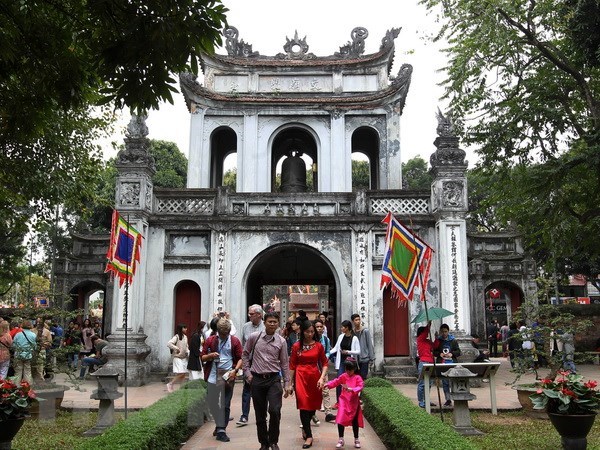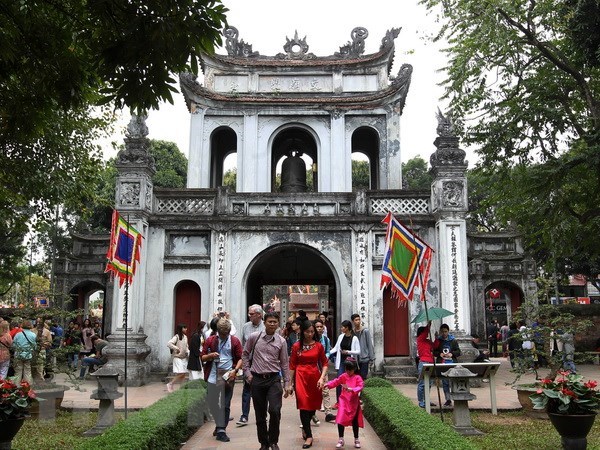
Representatives from 65 Japanese and Hanoi firms joined a programme to promote tourism in the capital Vietnamese city on August 24.

Van Mieu - Quoc Tu Giam in Hanoi (Source: VNA)
Japanese guests enjoyed folk music performances, watched a clip
introducing Hanoi’s tourism which was produced by the US’ CNN television
channel, and met with local businesses and the media to learn about the city’s
tourism products and destinations.
They gained an insight into Hanoi’s tangible and intangible heritages,
ecological tourism and entertainment areas, shopping centres, travel agencies,
lodging facilities, transportation, and tourism linkage with other
localities.
Tran Duc Hai, Director of the municipal Department of Tourism, said foreign
arrivals to Hanoi grew by 18 percent annually during the 2015-2017 period,
hitting 4.95 million people last year, up 23 percent year-on-year. In the first
seven months of the year, the figure rose by 21 percent year-on-year to reach
3.4 million.
Japan remained among the top three sources of tourists to Hanoi with 290,170
arrivals last year, up 22 percent annually. The seven-month figure was 166,437,
marking an 8 percent year-on-year increase.
Hai committed all possible support for Japanese travel agencies, press outlets,
and tourists in the near future and expressed his hope that Japanese firms will
offer more tours to Vietnam and Hanoi in particular.
Ara Saeko from JTB tourism company expressed wishes that Vietnam’s tourism
sector would upgrade local infrastructure, relax visa procedures, adjust tour
prices and better popularise destinations to attract more Japanese
visitors.
Japanese guests also visited Thang Long imperial citadel, Van Mieu-Quoc Tu
Giam, Hanoi’s Old Quarter, Duong Lam ancient village, Van Phuc silk village,
and Ha Long Bay in the northern province of Quang Ninh. –VNA
Source: NDO
Boasting favourable transport system, stunning landscapes, and an array of wellness resorts, Hoa Binh has been an ideal antidote for relieving stress.
April 30th and May 1st with 5 days off is the ideal time for families to choose the relaxing destinations and find a peaceful place. Thanks to the advantage of convenient transportation, mountainous terrain with wild beauty, cool climate, the resorts and health care areas in Hoa Binh province attract tourists on this occasion.
Currently, the tourism products of Yen Thuy district are mainly the festival and spiritual tourism. In addition to ensuring a civilized lifestyle in the religious activities, the party committees and the local authorities at all levels always focus on preserving the value of historical, cultural relics and festivals associated with exploiting tourism strengths.
The picturesque scenery of Hoa Binh Lake has endowed its tourism site with a unique allure. In recent years, localities have been harnessing the potential of the lake area and domestic and international tourists have chosen the site for sightseeing and leisure journeys.
The Hoa Binh Lake tourism area is expected to become a national tourism site by 2030, focusing on developing synchronous and modern technical facilities, and high-quality and branded tourism products imbued with national cultural identities. The tourist site also aims to become the largest tourist centre in the province, and one of 12 key tourist areas in the Northern midland and mountainous region
On April 5th, in Hoa Binh city, the Tourism Association of Hoa Binh province and Tourism Association of Ba Ria - Vung Tau province jointly organized a conference to promote cooperation and tourism development. There was the attendance of Mr. Nguyen Van Toan, the Vice Chairman of the Provincial People's Committee.



